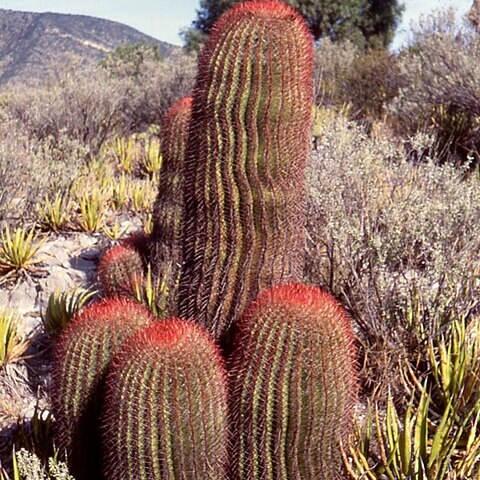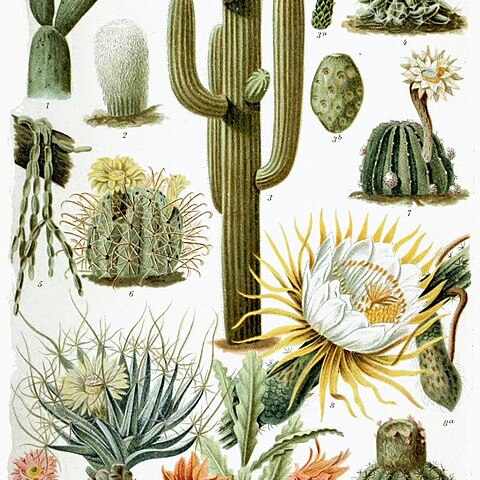Perennial shrubs or trees, sometimes scandent, terrestrial or rarely epiphytic, with shoots differentiated into usually succulent long shoots, and short shoots. Roots fibrous or tuberous. Stems unsegmented or segmented, the segments persistent to easily detachable; long shoots cylindric, globular, club-shaped or sometimes flattened cladodes (commonly called pads), ribbed, winged, with tubercles or smooth; short shoots (areoles) positioned on crests of ribs, at or near tubercle apices, or in axils of tubercles, often bearing a persistent spine or spine cluster, sometimes also bearing minute, irritating, barbed, deciduous spines (glochids) in subfam. Opuntioideae, and dense hairs (wool) forming a pulvinate structure; with crassulacean acid metabolism (CAM). Leaves on long shoots alternate, spiral, simple, entire, usually rudimentary and caducous or absent, or rarely well-developed and persistent, usually sessile (rarely petiolate to subsessile, e.g. in Pereskia); leaves of short shoots modified into spines; stipules absent. Flowers actinomorphic or zygomorphic, usually bisexual, mostly sessile, solitary or rarely several per areole, arranged in true inflorescence (racemose-paniculate or cymose-paniculate) only in subfam. Pereskioideae, or chains of fruits proliferating from fruit areoles (in some Opuntioideae), sessile or rarely pedicellate (Pereskia), receptacle ± produced beyond the apex of the ovary (pericarpel), and between ovary and perianth (hypanthium; "tube"), hypanthium rarely absent (Leuenbergeria-not in Australia, Pereskia, some members of Opuntioideae), outer surface naked or invested with leaf-like bracts, scales, areoles, and hairs, bristles or spines; epigynous or rarely perigynous (some Pereskia species). Tepals many, appearing ± free and inserted on pericarpel rim or united into a hypanthium, in a graded series, the outer lobes scale-like to sepaloid, the inner petaloid. Stamens many, inserted on pericarpel rim or on hypanthium, free or the inner connate; anthers dithecal, basifixed, introrse, longitudinally dehiscent. Carpels 3–numerous, connate. Ovary usually inferior (rarely half-inferior or superior in some Pereskia species), embedded in a receptacle that extends above the ovary into a hypanthium, rarely subsuperior, 1-locular; placentation almost always parietal (rarely basal, in Pereskia), placentas 3–many; ovules numerous; style 1, terminal; stigmas 3–many. Nectary a ring on inner surface of hypanthium. Fruit berry-like, variably succulent, the outer surface naked or usually with spines and/or glochids at areoles, indehiscent or variously dehiscent. Seeds few to many, mostly compressed, glabrous or rarely pubescent, sometimes strophiolate or arillate (funicular envelope) in subfam. Opuntioideae; the testa smooth, glossy, or minutely ornamented, often black; endosperm absent or occasionally perisperm present.
Fleshy perennials, shrubs, trees or vines, terrestrial or epiphytic. Stems jointed, terete, globose, flattened, or fluted, mostly leafless and variously spiny. Leaves alternate, flat or subulate to terete, vestigial, or entirely absent; spines, glochids (easily detached, small, bristlelike spines), and flowers always arising from cushionlike, axillary areoles (modified short shoots). Flowers solitary, sessile, rarely clustered and stalked (in Pereskia), bisexual, rarely unisexual, actinomorphic or occasionally zygomorphic. Receptacle tube (hypanthium or perianth tube) absent or short to elongate, naked or invested with leaflike bracts, scales, areoles, and hairs, bristles, or spines; perianth segments usually numerous, in a sepaloid to petaloid series. Stamens numerous, variously inserted in throat and tube; anthers 2-loculed, dehiscing longitudinally. Ovary (pericarpel) inferior, rarely superior, 1-loculed, with 3 to many parietal (rarely basal) placentas; ovules usually numerous; style 1; stigmas 2 to numerous, papillate, rarely 2-fid. Fruit juicy or dry, naked, scaly, hairy, bristly, or spiny, indehiscent or dehiscent, when juicy then pulp derived from often deliquescent funicles (except in Pereskia). Seeds usually numerous, often arillate or strophiolate; embryo curved or rarely straight; endosperm present or absent; cotyledons reduced or vestigial, rarely leaflike.
Highly specialized fleshy perennials of diverse habit. Stems terete, globular, flattened or fluted, mostly leafless and variously spiny; spines always arising from complex axillary structures (areoles). Flowers solitary or rarely clustered, sessile (except in Pereskia), almost always bisexual, usually regular. Perianth segments ?, closely imbricated in bud, in a sepaloid to petaloid series, ± free or fused below to form a short or elongate tube (hypanthium). Stamens ?; filaments variously inserted on or at base of perianth; anthers 2-thecous, splitting longitudinally. Ovary almost always inferior, with 3–? parietal placentas; ovules ?; style single; stigma-lobes 3–?. Fruit a dry or juicy berry, often spiny, bristly or scaly. Seeds ?, variously arillate or carunculate, with or without endosperm; embryo straight or curved
Flowers solitary on areoles, sessile (except in Pereskia), bisexual, usually actinomorphic; perianth segments ? (5–13 in species of FZ area), imbricate in bud, with gradual transition between sepals and petals, fused below to form a tube (hypanthium)
Carpels 3–?, syncarpous; ovary inferior, unilocular with 3–? parietal placentas; ovules ?; style single with 3–? stigmatic lobes
Succulent perennials with stems of varied shape and bristles arising from complex axillary structures (areoles)
Calyx-tube adnate to the ovary and often produced beyond; lobes few to many, or reduced to minute teeth
Flowers hermaphrodite, actinomorphic, often handsome, but very small in the African species (Rhipsalis)
Succulent herbs and shrubs of diverse habit, often very spiny, and usually with much reduced leaves
Ovary inferior, 1-celled, with parietal many-or rarely few-ovuled placentas; stigma usually radiate
Stamens ?, inserted at base of perianth; anthers 2-thecous, splitting longitudinally
Stamens numerous, free or adnate to the base of the petals
Seeds mostly without endosperm
Fruit baccate, many-seeded
Petals 6 or more
Fruit a berry
Seeds ?


